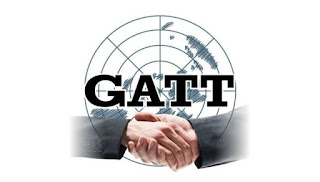The General agreements on Tariffs and Trade || purpose of GATT || GATT || Advantage of GATT || Disadvantage Of GATT || GATT and WTO
The General Agreement on Tariffs and Trade (GATT)
The General
Agreement on Tariffs and Trade (GATT), signed on Oct. 30, 1947, by 23
countries, was a legal agreement minimizing barriers to international
trade by
eliminating or reducing quotas, tariffs, and subsidies while preserving significant
regulations. The GATT was intended to boost economic recovery after World War
II through reconstructing and liberalizing global trade.
The GATT went
into effect on Jan. 1, 1948. Since that beginning it has been refined,
eventually leading to the creation of the World Trade Organization (WTO) on January 1, 1995, which
absorbed and extended it. By this time 125 nations were signatories to its
agreements, which covered about 90% of global trade.
Purpose of the
GATT
The purpose of
GATT was to eliminate harmful trade protectionism. That had sent global trade down 66%
during the Great Depression. GATT restored economic health to the
world after the devastation of the Depression and World War II.
GATT and
WTO
GATT lives on as the foundation of the WTO. The 1947
agreement itself is defunct. But, its provisions were incorporated into the
GATT 1994 agreement. That was designed to keep the trade agreements going while
the WTO was being set up. So, the GATT 1994 is itself a component of the WTO
Agreement.
Advantage of GATT
- GATT encouraged international trade.
- Countries with trading agreements are less likely to go
to war with one another.
- The success of GATT inspired other international deals
and organizations.
- Trade increases communication.
Disadvantages of GATT
- Domestic industries that can't compete globally will
likely fail.
- The globalization of industries exposes more of the
world to risks within that industry.
- Trade agreements could overrule domestic law, forcing
governments to cede some level of control over their citizens.



Comments
Post a Comment